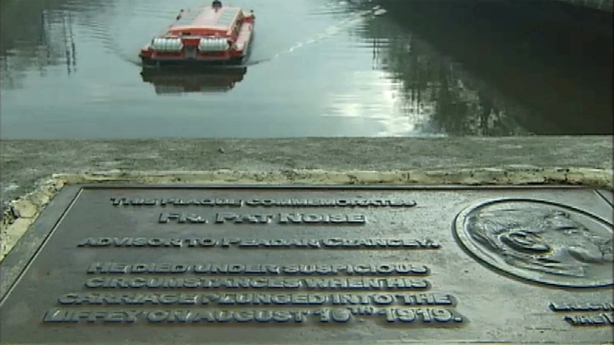On the Western side of O’Connell bridge in the heart of Dublin city, there’s a little 8x6 inch space. It's a cavity cut into the balustrade on the bridge.
That tiny space was first cut into O'Connell Bridge in 1996 to house the postcard machine to the Millennium clock, which was spectacularly launched on The Late Late Show in March 1996. Back then, the entire country got caught up in counting down the start or end to the Millennium. There was almost a sort of armageddon expected – which of course never materialised.
The Millennium clock was to help us count down, second by second, to the horizon of a new millennium. The clock itself was a huge 6 tonne digital clock floating just under the surface of the river Liffey at O’Connell Bridge. As part of the Millennium clock ‘experience’, you simply popped 20p into a postcard machine which was etched into this 6*8" space on the balustrade on O’Connell ridge - and out popped a postcard with the time remaining to the millennium printed on it. This was history in the making. However, eight years after the Millennium clock and it’s postcard machine were gone, a very different resident took up the 6*8" space that was left behind on O’Connell bridge.
We need your consent to load this SoundCloud contentWe use SoundCloud to manage extra content that can set cookies on your device and collect data about your activity. Please review their details and accept them to load the content.Manage Preferences
The clock, you see, was a disaster. Despite being almost two years in the making, at a cost of £250,000, it rarely worked. The algae in the river was one major obstacle. The ‘Chime in the Slime’ as it was nicknamed, came out of the Liffey in December 1996, just a few short months after it had gone in. The Millennium clock countdown was over, almost before it began. It was, to put it mildly, a PR fiasco for the National Lottery – the organization who was the brainchild behind the much lauded, and hugely heralded, Millennium Clock. It disappeared with a whimper.
For 8 years, and the 6'8 inch space that previously hosted the Millennium Clock postcard machine lay empty. However, in 2004, persons unknown installed a plaque in this space – to somebody called Fr.Pat Noise. But who was Fr. Pat noise? It took two years before anyone seemed to notice this 6*8 inch plaque until journalist Eoin Rice brought it to the attention of Dublin City Council. The council acted swiftly to remove the plaque. However, Fr Pat Noise was not ready to go away. Some months later, a replacement plaque to Fr Pat Noise was installed - and again Dublin City Council ordered its removal. This time the plaque to Fr Pat Noise had friends in high places. Councillor Dermot Lacey passed a motion to save the plaque. The big question was – who was Fr Pat Noise – and did he actually exist? Some said this was a very elaborate hoax - others bought into the existence of a Fr Pat Noise.

When we were piecing together this story for this documentary, we noticed a number of strange convergences. Pat Noise, as the plaque recalls, died when his carriage hurtled into the river Liffey, off O’Connell Bridge, in 1919. The noise was apparently an advisor to Peadar Clancy, at the time a senior Republican figure. The truth is no one seems to know a great deal about Fr Pat Noise, although it was rumoured he was obsessed with time and the philosophy of time. So almost 80 years after his death, it was an eerie coincidence that a plaque was placed to this eccentric man, exactly at the scene which was once occupied by a giant Millennium clock.
Could this be just a coincidence?
The existence or otherwise of Fr Pat Noise could probably have been more the focus of a documentary like this - but the further we got into the research the more it became apparent to us that his existence was irrelevant. The thing is, the plaque to Fr Pat Noise had the real impact on people. It has inspired balladeers and musicians to write songs by Fr Pat Noise. There’s even a Dublin hip-hop artist who goes by the name of Fr Pat Noise. But perhaps most of all, it inspired a campaign by ordinary people and a few notable local representatives against the power of Dublin Cty Council to save the plaque. It gave people a cause to rally around, something to fight for, a sense of intrigue and mystery. Today, the plaque to Fr Pat noise still resides in a 6*8inch space on O’Connell bridge, there for us all to see.
Contrast this with the millennium clock. Unveiled to huge fanfare and constructed at great expense, it left almost no mark in the hearts and minds of the capital.
If we were to say what this documentary was about then, we’d say it was about impact. We’d also say it was about how, curiously, the impact is not related to scale. It doesn’t matter how big something is. It doesn’t matter how expensive it is. It doesn’t matter that it’s launched on the country’s biggest television programme. Impact seems to be more about capturing people’s imagination. Giving them something to engage with.
It seems an unassuming little plaque to Fr Pat noise mysteriously installed on O’Connell Bridge, did just that.
Documentary On One: A Man Out Of Time, RTÉ Radio 1 Saturday November 18th @2pm, Repeat Sunday November 19th @7pm, RTÉ Radio 1
Now available online
By Jason Murphy and Donal O'Herlihy
